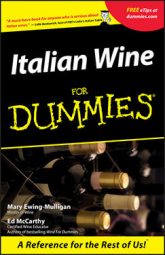Italian red wines bring up the image of grape-stomping parties that provide fun for the whole village. Fortunately, you don't have to press the grapes yourself to enjoy a bottle of good Italian red wine. The major reds are described in the following list:
Amarone: Lusty, full-bodied wine from partially-dried Corvina grapes, in the Veneto region. Dry and firm wine, but its ripe, concentrated fruitiness suggests sweetness. Needs rich, savory foods or flavorful cheeses.
Barbaresco: Similar to Barolo, from the same grape in a nearby area, but generally a tad lighter in body and slightly more approachable. Drinks best at 8 to 15 years of age, depending on the producer.
Barbera: Varietal wine produced mainly in the Piedmont region. Dry, light- or medium-bodied, with intense berry flavor, mouth-watering acidity, and little tannin. Particularly versatile with food. Many of the best wines are from the Alba or Asti zones.
Barolo: Dry, full-bodied, magisterial wine from Nebbiolo grapes in the Barolo area of Piedmont. Has complex aromas and flavors of strawberries, tar, herbs, and earth, as well as a firm, tannic structure. Drinks best at 10 to 20 years of age, depending on the producer.
Brunello di Montalcino: Full-bodied, intense, concentrated wine from Sangiovese grapes grown in the Montalcino zone of Tuscany. Dry and quite tannic, it drinks best when it's at least 15 years old.
Chianti: Very dry, medium-bodied, moderately tannic wine with lovely tart-cherry flavor, mainly from Sangiovese grapes grown in the Chianti area of Tuscany. "Chianti Classico" is often the best. Some wines are good young; wines labeled riserva, and pricier wines, are generally more concentrated and age-worthy.
Lambrusco: Most commonly a sweet, fizzy wine with delicious, grapey flavors. Made from Lambrusco grapes usually in the Emilia-Romagna region. Dry and sparkling styles also exist.
Montepulciano d'Abruzzo: Generally medium-bodied and flavorful with red fruits and a slightly vegetal note. Lighter examples are smooth and easy to drink; the best wines are concentrated and denser in texture. From the Montepulciano grape, in the Abruzzo region.
Salice Salentino: Dry, full-bodied wine from Negroamaro grapes in part of the Puglia region. Generally has somewhat intense aromas and flavors of ripe, plummy, baked fruit, and rich, dense texture. Suitable with robust foods.
Valpolicella: Medium-bodied wine mainly from Corvina grapes in the Valpolicella area of Veneto region. Dry, lean, and only moderately tannic, with more or less intense cherry aromas and flavors. Some versions, such as single-vineyard wines, are particularly good.
Vino Nobile di Montepulciano: Medium-bodied, dry, and lean, with red cherry flavor, similar to Chianti but slightly fuller. Made from Sangiovese grapes in Montepulciano, in the Tuscany region.

